- Home
- Expeditions
- INSPIRE: Chile Margin 2012
- Mission Logs
- April 21
How many of you have ever seen the movie Contact? There is a scene in which the main character, played by Jodie Foster, arrives somewhere so beautiful that she loses the power to speak and describe it. That was pretty much what we experienced today.
Twenty-something years ago, when I was writing up my PhD, I watched a mini-series of TV shows on the BBC in the UK called "Flight of the Condor"; it described the natural history of this region in a journey that started at the southernmost end of the Andes, and seemed to me to be some of the most beautiful images I had ever seen – and I didn't even have a color TV! Today, I got to realize a long-held ambition to sail through this region and see it for myself, first hand. I took over 300 photographs and, cumulatively, was out on deck whenever I got the chance from as soon as it got light around 8am through to just after sunset, nearly 12 hours later. I did get some other work done in the past 24 hours, and we did also have a series of meetings, starting with a safety briefing last night where we learned how to don our survival suits. Then there were four sets of meetings today: a science introduction by Donna, me and Andrew (who was chief scientist on our 2010 expedition); a fire- and life-boat drill (in the most heart-breakingly beautiful setting that I will ever do a fire-drill); a watch-keepers' instruction briefing (on how to work all the different computer systems to monitor what we'll be doing when we start work) and then a Principal Investigators' meeting to talk through the various options we want to have up our sleeve for the first 24 hours when we arrive in our work area. These options are dependent on whether we arrive early, on schedule or late, whether the weather is good enough to start work on schedule (which looks likely) and whether it will stay good throughout that first 24 hours or not (because launching an AUV is easy, but getting it back safely is important too).
But I must admit, whenever I wasn't working today, I was pretty much goofing off on deck taking in the view, trying desperately – and failing – to capture the magnificence of the scenery, and only taking a break for warming my hands round a cup of coffee while I emptied out the memory card and got ready to head out on deck again. I'm not going to write more here, but, instead, tell the story of the day through my top ten favorite pictures of the day. Here's hoping I'll be forgiven for sending that many photos ashore!

This photo looks like it was taken in early light – and does convey how dark and foreboding the light was in early morning - but was actually taken around 11am, two hours on from when I first stepped out on deck.
Image courtesy of Chris German, INSPIRE: Chile Margin 2012, NOAA-OER.
Download larger version (jpg, 1.5 MB).
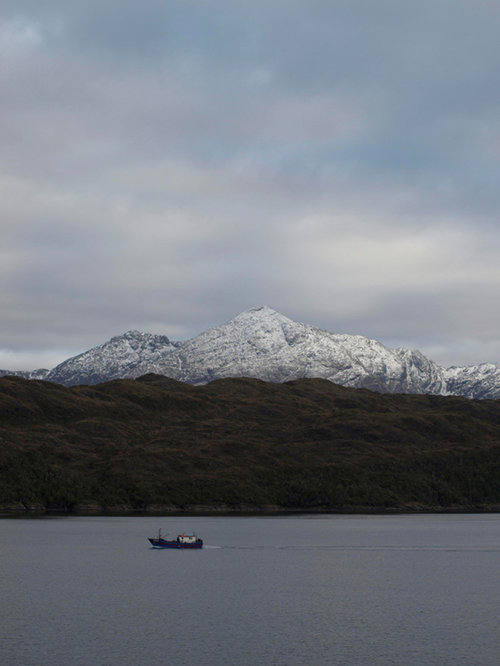
Just 15 minutes later we saw one of our few sightings of other human activity as the sun began to break through. A pair of local fishing boats heading in the opposite direction, this one posed neatly in front of this snow-capped (extinct or dormant?) volcano.
Image courtesy of Chris German, INSPIRE: Chile Margin 2012, NOAA-OER.
Download larger version (jpg, 1.8 MB).
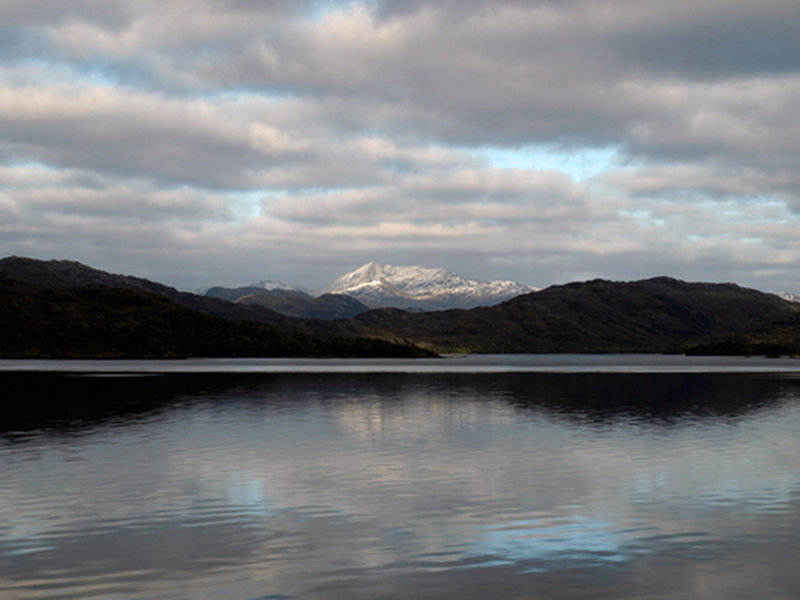
Multiple times during the day we were treated to views like this. As the clouds began to break, we even got to see patches of blue sky reflected in the water.
Image courtesy of Chris German, INSPIRE: Chile Margin 2012, NOAA-OER.
Download larger version (jpg, 2.0 MB).
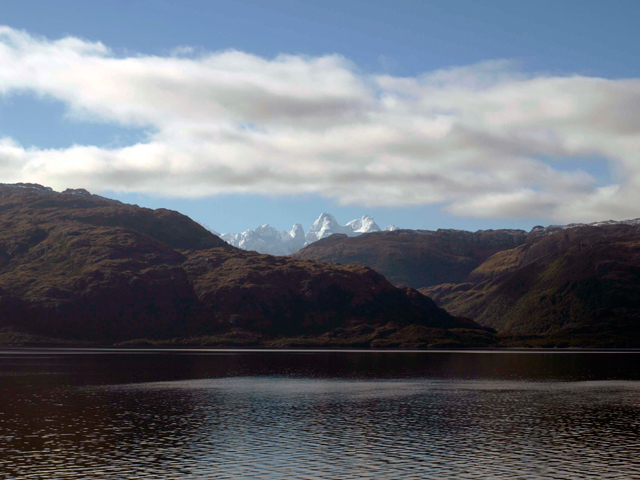
While I have also had the privilege in recent years of sailing out to sea through the fjords of northern Norway, what really struck me today was how much steeper and dramatic the tall peaks here seem to be. This was the view, right around the time we were all REQUIRED to be out on deck, learning how to launch the ship’s liferafts if the need ever arose. There are worse ways to spend your day!
Image courtesy of Chris German, INSPIRE: Chile Margin 2012, NOAA-OER.
Download larger version (jpg, 2.1 MB).
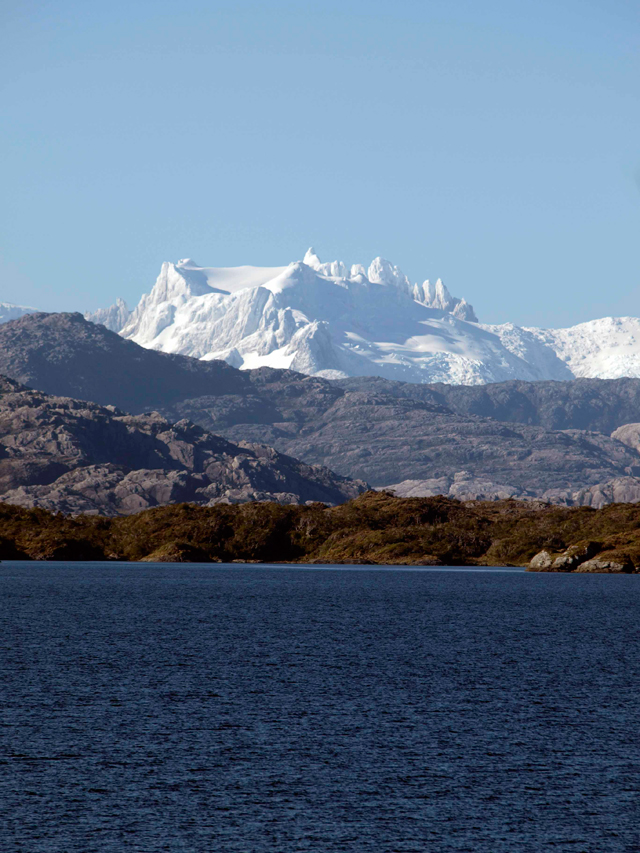
Marv dubbed this one the Snow Castle. With poetry like that in his soul, we should probably let him name any new vent-sites we find, too.
Image courtesy of Chris German, INSPIRE: Chile Margin 2012, NOAA-OER.
Download larger version (jpg, 4.0 MB).

Just after dinner, Eulogio came to tell Marv, Koichi and me (who were all busy discussing our 2010 hydrothermal plume data) that there was a field of small ice-lumps ahead – evidently calving off a glacier and entering the sea. This was one of the first such we passed, posed in front of another conical (ex-)volcano. If you look closely near the shore-line on the left you can see a small white mini-lighthouse. We have passed many dozens of these that will continue to light our way safely through these narrow channels overnight. The pilot told Ko-ichi that they used to be powered by propane gas but have now been converted to solar power.
Image courtesy of Chris German, INSPIRE: Chile Margin 2012, NOAA-OER.
Download larger version (jpg, 2.4 MB).
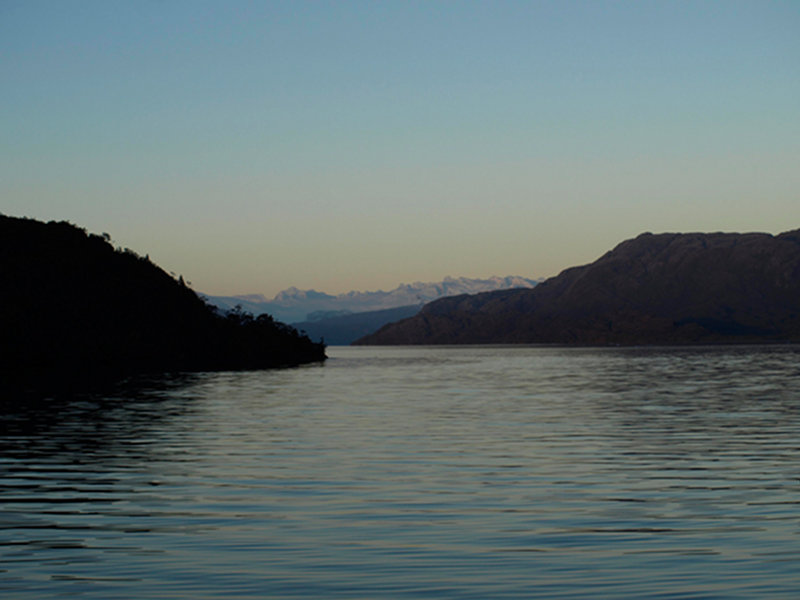
A recurrent conversation on deck, today, focused on marveling at how the early navigators, hundreds of years ago, first found their way through this bewildering array of channels that kept opening up as the day progressed. I wonder what we would have found if we had taken a side-track up this channel, for example?
Image courtesy of Chris German, INSPIRE: Chile Margin 2012, NOAA-OER.
Download larger version (jpg, 2.1 MB).

Just as the light was finally fading it seemed like the channel we were in was opening out – we even felt the ship sway for the first time in hours, we had such flat-calm seas today. But then we rounded a corner and realized that our entire way ahead was blocked by another, far-distant, mountain range.
Image courtesy of Chris German, INSPIRE: Chile Margin 2012, NOAA-OER.
Download larger version (jpg, 2.4 MB).
Previous
Next
